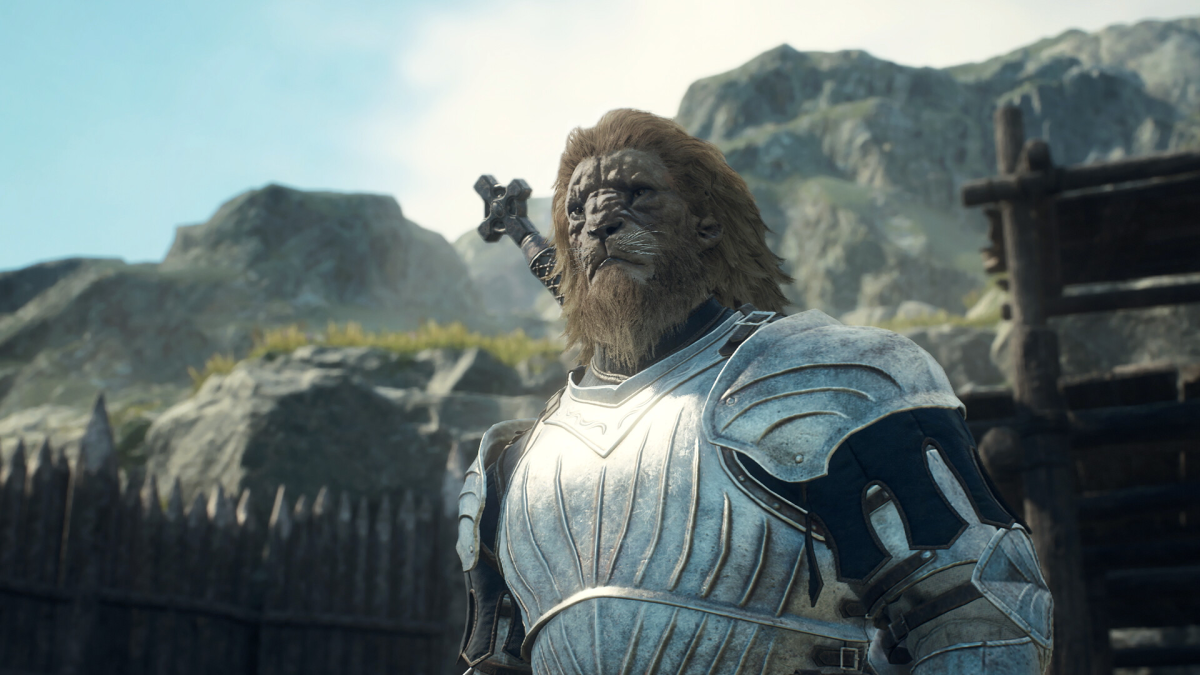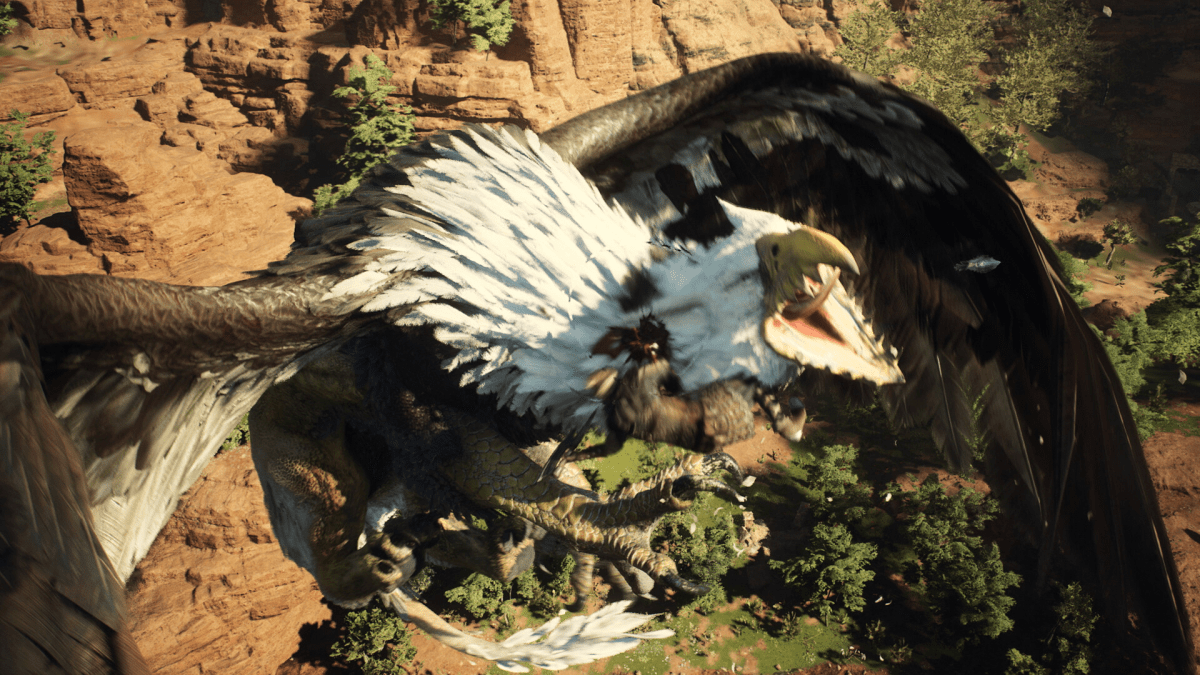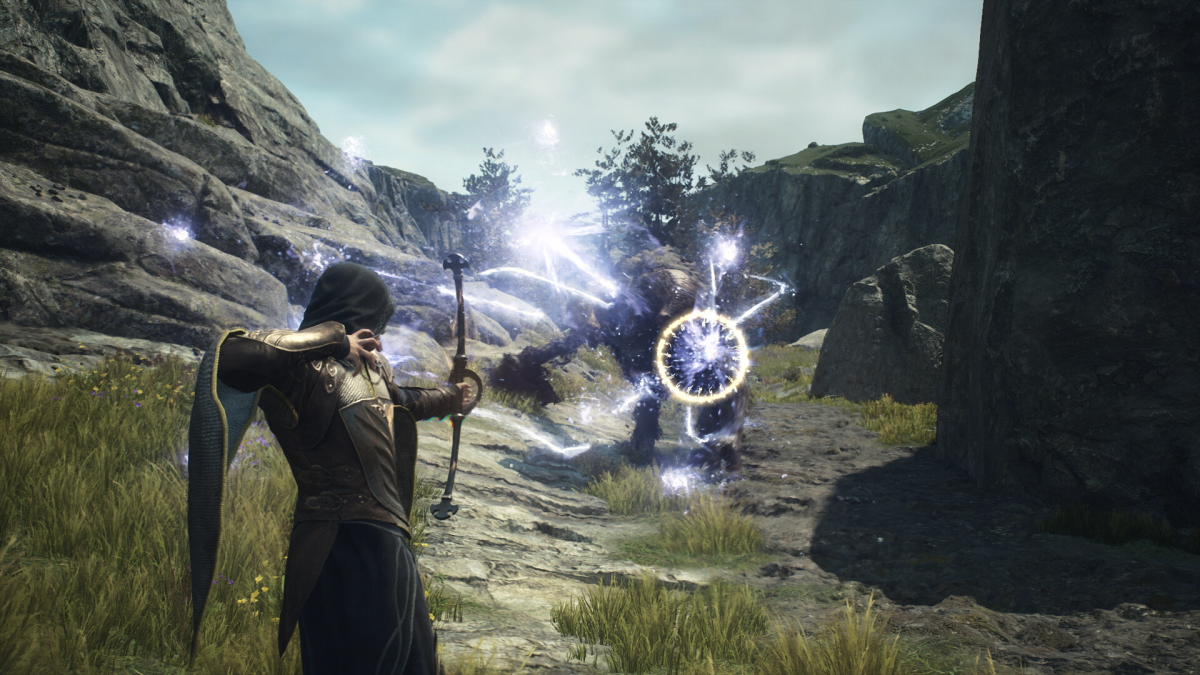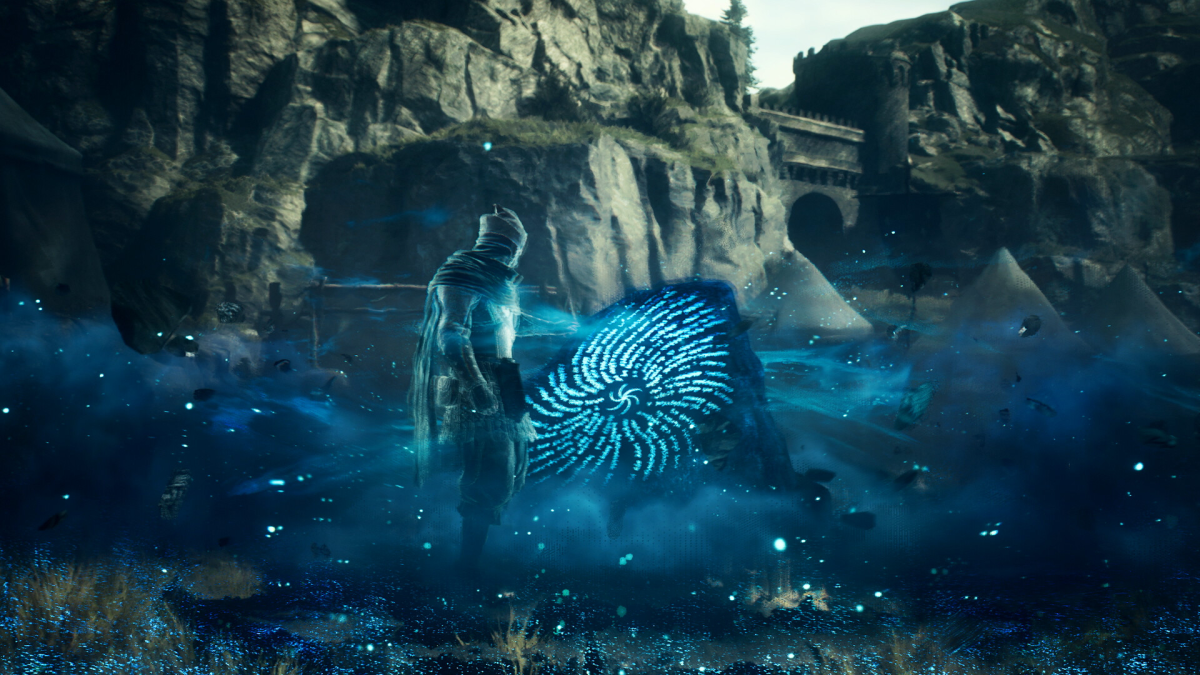When Dragon’s Dogma released in 2012, I immediately picked up a copy at a local GameStop. I was looking for ways to pass the time, and had seen the boyfriend of a friend play it briefly on their PlayStation 3 when I had visited. It looked interesting enough, and so I thought I’d give it a spin. Dragon’s Dogma easily became one of my favorite action RPGs of all time, if not one of my favorite fantasy titles, due to its inspired use of European fantasy and the myth-making around dragons. I loved the scenario, I loved the gameplay, and I loved the world. I was thrilled to see Dragon’s Dogma 2 announced, in awe of what I was shown and what I played during several preview sessions. But did Dragon’s Dogma 2 live up to the expectations I had foolishly set for myself? The answer is yes, and then some.
Dragon’s Dogma 2 throws the player into the thick of things immediately, but does so to the benefit of the player. You assume the role of the Arisen, a figure that can control and form bonds with Pawns (beings from another dimension). Your avatar has no real recollection of who they are. The game uses this as a way to introduce players to the world, explaining the role of the Pawns, the region you reside in, and the current socio-political climate between two major powers as a new Sovran has been made the ruler of Vernworth. I am a sucker for low fantasy settings, even more so if there is some kind of political intrigue involved, and Dragon’s Dogma 2 didn’t disappoint. I attended masquerades to learn about the new (false) Sovran. I traveled to Melve to recover some of my lost memories, unearthing who I was before escaping the mines of the volcanic island. I met with the captain of the city guard who hoped to reinstate me as the rightful ruler of the kingdom. And there was so much more I could do alongside this to further unearth the events that lead to my imprisonment and falsified death.

You can choose to engage and unravel the political scheming of the Queen Regent Disa and the tenuous relationship between Vernworth and the Beastren capital of Bakbattahl, or you can ignore this for the most part to explore and engage with the world at will. Dragon’s Dogma 2 allows you to chart your own course, outside of a few mandatory story quests you can choose to undertake on your own time. Each of primary locales are culturally distinct, with Vernworth ascribing to all of the trappings of European low fantasy, with knights in steel plate and all. On the other hand, Bakbattahl resides in the southern desert. The large city is made of smooth, red-brown stone with its trappings smacking of Orientalism, what with long pipes and ornate rugs found in just about every establishment. The aesthetics of Southwestern Asia and North Africa are solely used as set dressing for the most part, but unlike other modern contemporaries, the populations of these cities are diverse and do feature people of color alongside their Beastren counterpart. (They exist in the clearly central European inspired city of Vernworth as well.) Vague commentary on racism between the two populations does exist in side content, along with the enslavement of Pawns by the sorcerers of Bakbattahl outside of their general treatment. For example, the Empress of Bakbattahl seeks to create equal footing for Pawns to help combat the discrimination they face. But exploring this narrative thread, among others, only takes place away from the main story. A lot of the meat of the game is sequestered away in this side content, which may leave players confused when it comes later events in the game and certain characters end up appearing in more prominent roles.
I ended up engaging a lot with the side content Dragon’s Dogma 2 had to offer. This is mostly because I was concerned about getting locked out of side-content and missing optional Vocations (which is the game’s job system), like the Mystic Spearhand and Magick Archer. I ended up accepting just about any quest I could find. The natural progression of some of these quests, at least in terms of where your final destination is, brought me to smaller settlements littered around the map. One of the first missions I chose to do involved helping an Elven Archer acquire a human-made bow. From there, he asked that I meet with him in some nearby ruins so that he could learn from me, as I was also an Archer at the time, and finally complete his coming of age ceremony.
On the way, I was waylaid by bandits, swooped upon by griffins and harpies, and rushed by minotaurs sometimes all at once. Dragon’s Dogma 2 is packed with random encounters, almost to the point of being annoying if you are ill-equipped and underprepared. You will absolutely run into encounters with goblins, wolves, and ogres while wandering during the day, as the reappearance of the Dragon and the crowning of a new Sovran has caused monsters to become more aggressive. Also, the game is not shy about throwing some of the most difficult random encounters your way, even at lower levels. That said, it does get a lot easier later on, especially if you grind out gear and levels. I actually wish the game was a bit harder, but I was also around level sixty when beating it and owned the best gear I could afford and upgrade.

After helping the Archer, I met up with him again. This led to my getting entangled with his family and aiding him in saving his sister. Which led to a further entanglement with his family, as both he and his father fell in love with me. I was a little awkward when both came knocking at my door for a date. If I hadn’t chosen to help this NPC, it wouldn’t have led me to other questlines in the world. The quests associated with the Archer’s sister took me to Bakbattahl, which then had me traveling elsewhere on the map to create a natural sense of progression between these various questlines that also resulted in me picking up even more quests and accidentally unlocking one of the late-game Vocations by chance.
It all feels very intricate, but also very random at times, since getting to your objective does not force you to walk a specific path. You see, I had not continued the main quests, which meant I couldn’t actually pass through the border at Rest Town to get to Bakbattahl with the use of a permit. No. I walked the entire length of the map to find a cave to get me around the border and into the desert region. I didn’t have to get the permit to make it there and I probably shouldn’t have been in Bakbattahl that early in the game, but the fact that Dragon’s Dogma 2 allowed for me to make my way there through sheer will and perseverance was amazing. II wasn’t until chatting with another Siliconera writer that there were quests that I undertook that could have various different outcomes from the ones that I had.
We were in wonder and awe as we shared stories with each other. Some had found secrets others hadn’t or Vocations we had yet to unlock. It felt like talking with friends in the schoolyard, discussing our shared, yet different, experience with a game we’d been playing. One had found out how to unlock Magick Archer. Another had retraced their steps to find an item to appease a specific NPC. While the end results were mostly the same, how we approached these quests were wholly different either because of the path we took or the Vocation we had equipped at the time. And some Vocations are certainly better than others.

While my impression of the Mystic Spearhand during the preview events Capcom had invited me to were middling, it became increasingly clear to me that this Vocation was one of the best. As I continued to force my way through content I was clearly underequipped for, I spammed the Mirour Shelde skill to block my party from any incoming damage. This included dragon fire and any kind of stun or stagger damage that may have impacted my party of Pawns. I also managed to leap over some terrain that would have otherwise been impassable if I had not used one of the Mystic Spearhand skills to more or less clip over a wall. It became my go-to class. Even if I loved what Capcom did with the Thief, it meant removing most melee capabilities for the Archer as a result. That said, my Pawn party remained mostly the same, with mine functioning as a Warrior with tank Augments and at least one Pawn designated to the party Mage, since they are the only class that is capable of healing to any great degree. I would play around with that third Pawn slot, sometimes taking an Archer or Thief with me, but at the end I had recruited Batsu, a level forty-nine Sorcerer with the Metereon spell. She made everything a joke once she was able to get this cast off without interruption thanks to Mirour Shelde, and everything would evaporate before her in plumes of smoke and molten rock. Thank you to the Capcom employee that made Batsu. I owe you my life.
Pawns can be recruited through Riftstones that are found on the map, or just by encountering them as they wander from settlement to settlement. Some can be recruited entirely for free, but in the case of a Pawn like Batsu, they can be extremely costly. She cost around 999RC, which is the currency required to hire one of these allies. They don’t deal in gold, but instead a unique currency that is gained from your Pawn accompanying other Arisen on their journey or by activating Riftstones on the map. I ended up acquiring quite a lot of it, so much so that I had an excess of 5,000RC by the end of my sixty hour playthrough. You can use RC on cosmetic items and what not, but I generally kept it for purchasing the service of powerful Pawns, because they are invaluable companions. Outside of what they can provide through their offensive capabilities, Pawns will remember what quests they have completed alongside their Arisen or other adventurers. Batsu, being as high level as she was, knew where most of my quest objectives were, what NPCs I’d need to talk to, or a rough approximation of chests in areas I was exploring. My own Pawn Liam would mention that he had learned about secret locations from his experience being recruited by another Arisen. Another Pawn I recruited had learned to throw enemies into the water or off cliffs to end combat quickly, so as I was leaping into combat with my daggers as a Thief, they were picking up goblins and chucking them into a nearby lake. The Pawn system is incredible, and Capcom improved upon it immensely.
The variety of things you can do, what you choose to complete, and how you choose to complete tasks reminds me of Baldur’s Gate III, just more fleshed out. Things seem to have longer lasting consequences. You can deceive NPCs and secret away rewards for yourself through the use of forgeries, or even save a life by keeping ancient and forbidden tomes from them. You can glean information by reading documents located in the castle itself by sneaking in disguised as a guard, through sulking in the shadows, or even other means that rely on Dragon’s Dogma 2‘s intricate NPC relationship web.. While all paths lead to similar end results, the journey there is vast and winding. There are some choices I’ve made that I knew ended up impacting certain events in the late-game, but on a second playthrough I’m going to see what inaction or a more thorough investigation will bring. The scope of the game is incredible, and given that it is a true open world experience is a technical marvel.

I did experience some hiccups however, as entering Vernworth dropped my FPS to a staggering 5FPS until it eventually stabilized. The game itself can also be rough around the edges, especially with how your Pawns choose to climb over rocks and navigate more dangerous paths. They will sometimes stumble and fall to their death (if there is water below, as no one in this game can swim), or be knocked unconscious. The user interface, as gorgeous as it is, did result in some eye strain. One of my eyes was blood-shot after a particularly long session due to the narrowness of the serifed font. These are things to take into consideration at the very least, even if I did have a fantastic time with the game, and affected my scoring.
There are still so many things I have left to do in Dragon’s Dogma 2. I have yet to uncover the full extent of the Queen Regent’s schemes, learn more about the Empress the people of Bakbattahl love so much, or solve the Sphinx’s riddles. But these are things I can do on a second playthrough, or even a third, as I take what I’ve learned with me. Dragon’s Dogma 2 feels vast in a way that no other game has in a very long time. It reminds me of the best of the original Dragon’s Dogma, with traces of The Elder Scrolls III: Morrowind weaved into it. It’s an incredible low fantasy epic ripe with political intrigue, should you choose to engage with it, and a fully realized world that leaves the right questions unanswered.
If you haven’t gotten a copy of Dragon’s Dogma 2 yet, it’s available on PlayStation 5, Xbox Series X/S, and PC.
Siliconera is supported by our audience. When you purchase through links on our site, we may earn a small affiliate commission. Learn more
Dragon’s Dogma 2 is a single player, narrative driven action-RPG that challenges the players to choose their own experience – from the appearance of their Arisen, their vocation, their party, how to approach different situations and more - in a truly immersive fantasy world. PC version reviewed. Review copy provided by company for testing purposes.
Dragon's Dogma 2 is a marvel, and perhaps one of the best games within Capcom's catalogue of already impressive titles.
- The game looks fantastic, even on low graphics settings and runs decently on lower end machines.
- I accidentally courted an Elf and has father. I have two boyfriends.
- The world feels wholly organic, with random events providing extra texture and revealing secrets.
- PC specs: AMD Ryzen 9 5900X 12-Core Processor, 32GB installed RAM, NVIDIA 3080ti


Published: Mar 20, 2024 11:01 am